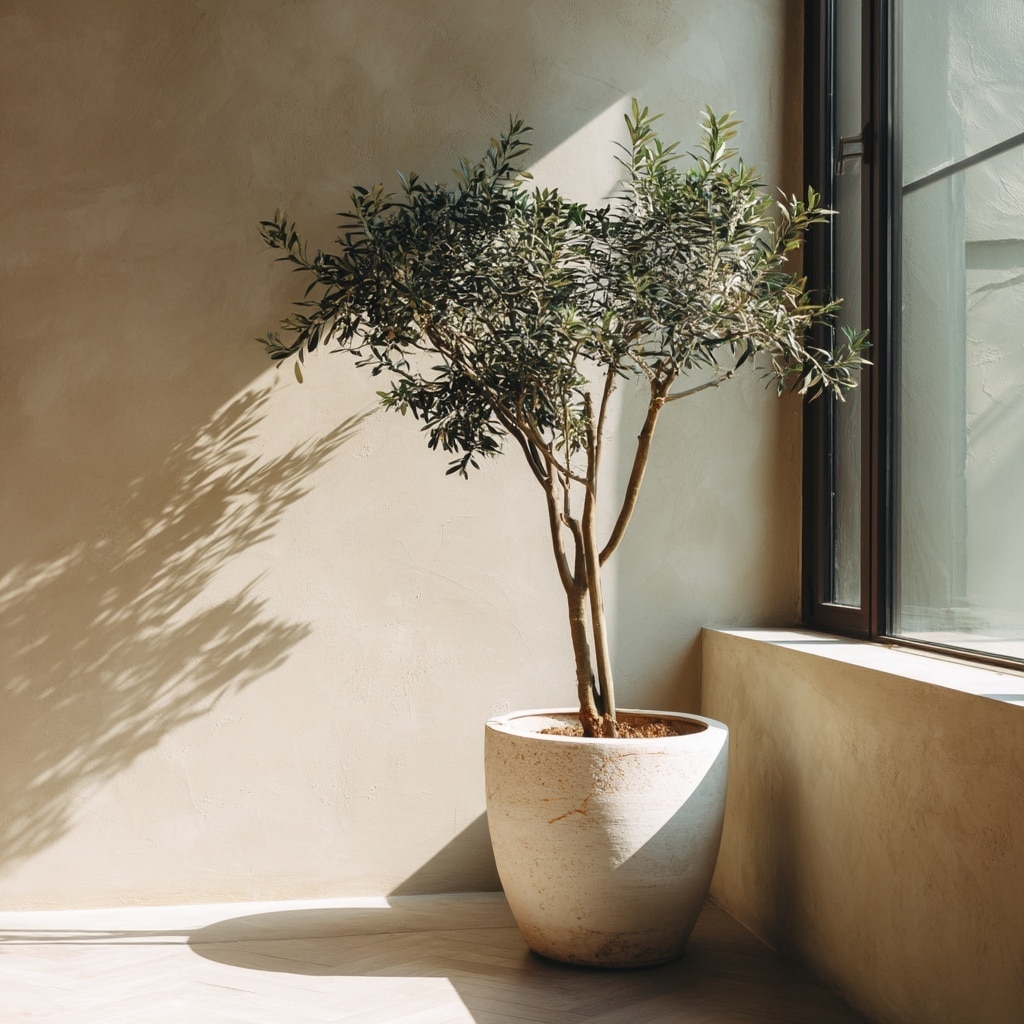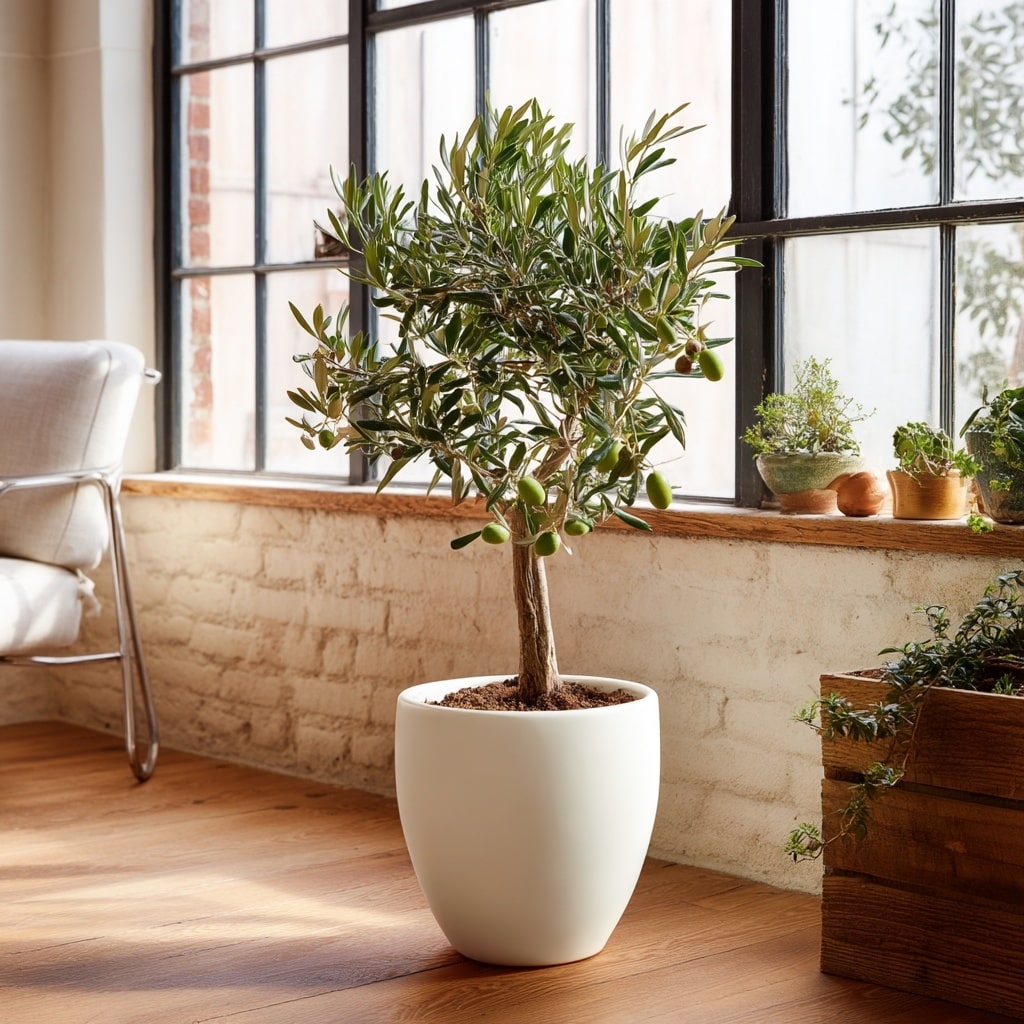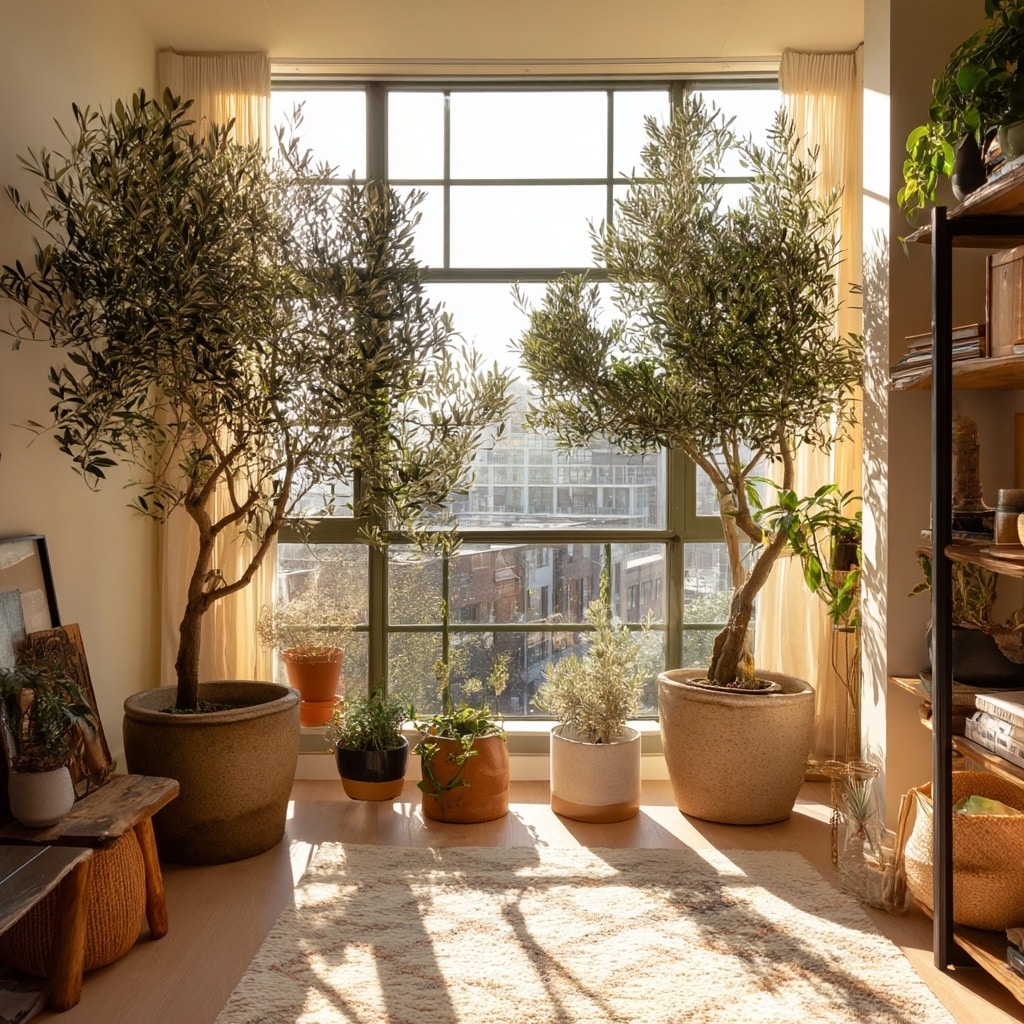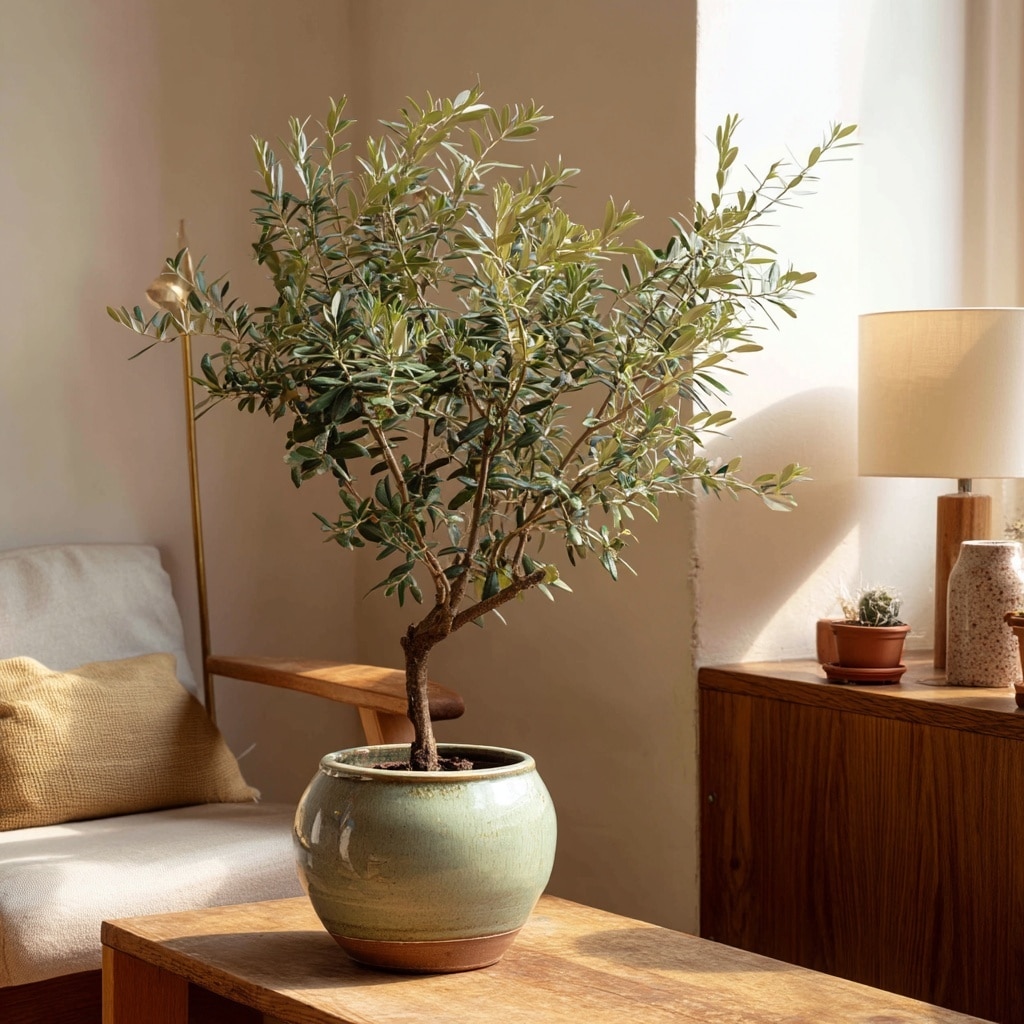Olive tree indoor growing has become one of the most stylish trends in houseplant design. With their silvery-green leaves, sculptural shape, and Mediterranean charm, olive trees bring a timeless elegance to indoor spaces. But beyond their beauty, they’re surprisingly practical—many compact varieties adapt well to container life and can thrive indoors with the right care.
Whether you’re craving a decorative focal point or hoping to harvest your own tiny crop of olives, choosing the right variety is essential. In this guide, we’ll explore six olive tree types best suited for indoor growing, along with expert tips to keep them healthy, compact, and productive in your home.
1. Arbequina Olive Tree
The Arbequina olive tree is one of the most popular choices for an olive tree indoor setup, and for good reason. Native to Catalonia in northeastern Spain, this variety stays relatively small when grown in containers, often reaching just 3 to 5 feet indoors.
🌞 Compact and Fruitful
Arbequina trees are known for their adaptability and are among the few olive varieties that can fruit indoors under the right conditions. With plenty of bright, direct sunlight and a warm room, you might see blossoms and olives as early as the first year.
Its soft, narrow leaves and rounded crown give it an ornamental appeal, making it just as beautiful as it is functional.
🪴 Ideal for Pots and Pruning
This variety tolerates pruning well, so you can easily manage its size and shape without stressing the plant. Its naturally bushy growth habit can be trained into a single-trunk tree or left as a compact shrub for smaller spaces like sunrooms or patios.
If you’re looking for a beautiful, fruit-bearing olive tree that adapts well to indoor conditions, Arbequina is a top contender.
2. Koroneiki Olive Tree

If you’re looking for a resilient olive tree indoor, the Koroneiki olive tree is an excellent choice. Native to southern Greece, this variety is widely grown for its high-quality oil and is loved for its hardiness and adaptability to dry conditions.
💧 Drought-Tolerant and Forgiving
What sets the Koroneiki apart is its impressive drought resistance. This makes it a smart pick for anyone who tends to forget a watering day here and there. While it still appreciates regular moisture during the growing season, it can tolerate dry spells better than most indoor olive trees.
Its narrow, dark green leaves and upright habit give it a clean, architectural look that complements modern interiors.
🪴 Small Size, Big Impact
The Koroneiki is a naturally smaller variety, usually growing up to 4 feet tall when potted indoors. It responds well to pruning and can be shaped to fit tight corners or windowsills with strong light.
Though it takes a bit longer to fruit indoors compared to others, it’s a rewarding tree for anyone who values beauty and resilience in a plant.
3. Amfissa Olive Tree

If you’re working with limited space but still want a true olive tree indoor, the Amfissa olive tree is a smart, compact choice. This variety comes from central Greece and is known for its rounded growth habit, making it ideal for small apartments, kitchens, or sunny nooks.
🪴 Naturally Compact and Manageable
Unlike larger varieties that require frequent pruning, the Amfissa tends to stay small on its own, often maxing out around 3 to 4 feet in containers. Its softer, oval-shaped leaves and bushy structure make it a charming ornamental addition, even in minimalist spaces.
🫒 Dual Purpose: Beauty and Fruit
Beyond its looks, the Amfissa tree produces small, flavorful olives that are often used for both oil and brining. While fruiting indoors takes extra effort—like sufficient light and a few months of cooler temperatures—it’s not out of reach for this adaptable variety.
Whether you’re going for aesthetics, fruit, or both, the Amfissa balances tradition and practicality in one neat package.
4. Mission Olive Tree

For those in cooler climates or who prefer a more temperate indoor environment, the Mission olive tree is a standout olive tree indoor option. Originally brought to California by Spanish missionaries, this variety has adapted beautifully to both indoor and outdoor settings in a wide range of temperatures.
❄️ Cold-Tolerant and Reliable
Unlike more heat-loving olive trees, the Mission variety is known for its cold hardiness. It handles indoor conditions where temperatures may dip slightly—perfect for drafty old homes or cooler sunrooms.
Even indoors, it retains a strong chance of fruiting if given enough direct light and a cool period during the winter months.
🌳 Stately and Productive
The Mission olive tree has a graceful upright form, with dark green, glossy leaves and smooth grey bark that brings character to any space. It can grow to about 5 feet indoors, but with thoughtful pruning, it stays manageable and attractive.
This variety produces both oil and table olives, making it a great dual-purpose tree for indoor growers who want both beauty and a potential harvest.
5. Manzanilla Olive Tree

For those who want a low-maintenance olive tree indoor that produces the most recognizable olives, the Manzanilla olive tree is a top pick. Native to Spain and famous for its green, pimento-stuffed olives, this variety brings both nostalgia and visual appeal into your home.
🐢 Slow-Growing and Easy to Maintain
The Manzanilla is a naturally slow-growing olive tree, which means less pruning and more manageable growth in containers. Indoors, it typically stays under 4 feet tall, making it ideal for apartments or smaller rooms.
Its dense canopy of soft, silvery-green leaves gives it a plush, full look that works well with both rustic and modern décor.
🌬️ Sensitive but Stunning
While the Manzanilla thrives in bright light, it’s a bit more sensitive to cold drafts than other varieties. Keep it away from exterior doors or chilly windows in the winter to avoid stress.
With care, this tree can reward you with small olives perfect for curing or simply enjoying the look of a fruiting plant indoors. It’s a beautiful balance of ornamental charm and edible potential.
6. French Picholine Olive Tree

If you’re looking for an elegant yet adaptable olive tree indoor, the French Picholine olive tree is a stylish and functional choice. Originating in southern France, this tree is prized for its slender shape, glossy leaves, and flavorful olives used for both oil and table snacking.
🇫🇷 Elegant and Upright Form
The Picholine has a more upright, narrow growth habit, making it well-suited for tight corners or narrow spaces near sunny windows. With its sleek silhouette and fine-textured foliage, it blends seamlessly into contemporary interiors or minimalist designs.
Indoors, it usually grows between 3 and 5 feet tall and responds well to regular pruning to maintain its size and shape.
🌱 Well-Suited for Indoor Life
This variety adapts particularly well to indoor temperatures and isn’t as fussy about humidity. It appreciates the same full sun and dry conditions most olive trees prefer but doesn’t mind a bit of environmental inconsistency now and then.
The olives themselves are green and slightly firm, known for their crisp texture and briny flavor. Whether you’re growing for looks or for a small yield, the Picholine offers both style and substance.
How to Care for Your Indoor Olive Tree

Olive trees may be drought-tolerant by nature, but when grown indoors, they do have specific care needs. The good news? Once you understand their preferences, they’re surprisingly low-maintenance.
☀️ Light Requirements
Your olive tree indoor will need at least 6 hours of direct sunlight daily. South- or west-facing windows are ideal. Without adequate light, growth will slow, leaves may drop, and fruiting is unlikely.
If natural light is limited, supplement with a full-spectrum grow light positioned 6–12 inches above the top of the tree.
💧 Watering Routine
During the active growing season (spring through early fall), water when the top inch of soil feels dry. Reduce watering in winter when the tree enters dormancy. Always empty the drainage tray to prevent root rot.
These trees prefer hot, dry indoor environments, so skip the humidifier—they’ll actually perform better in the warmest spot in your home.
🌡️ Temperature Tips
Most olive trees prefer temperatures between 65–80°F during the day. If you’re hoping for fruit, give your tree a “chilling period” in winter—about 2–3 months around 50°F. A bright, unheated sunroom or a draft-free cool window can help simulate this.
Soil, Pruning, and Fertilizer Tips for Indoor Olive Trees

While olive trees are relatively unfussy, proper soil and maintenance make all the difference in keeping your indoor tree healthy and well-shaped.
🪵 Best Soil for Indoor Olive Trees
Drainage is critical. Use a fast-draining cactus or citrus potting mix to prevent soggy roots. For even better airflow and drainage, mix in perlite, pumice, or bark chips. Always choose pots with drainage holes and empty trays promptly after watering.
Repot every 2–3 years, or when roots begin circling the container. Refresh the soil during repotting to prevent nutrient depletion and compaction.
✂️ How to Prune Olive Trees Indoors
Prune for shape and airflow, especially in late winter or early spring before new growth begins. Remove crossing branches, thin dense areas, and trim to maintain your desired size.
If your goal is fruit production, do not cut back new growth—that’s where next season’s fruit will form. Instead, prune off old fruiting stems and keep the crown open to light.
Avoid pruning during the first year unless absolutely necessary; the plant needs time to establish.
🌿 Fertilizing Tips
During the growing season, feed your olive tree indoor every 2–4 weeks with a balanced liquid fertilizer (like 10-10-10 or 1-1-1 NPK). Hold off during winter months when the tree is dormant.
Consistent, light feeding encourages stronger growth and better chances of flowering and fruiting indoors.
Conclusion
Growing an olive tree indoor adds timeless charm, texture, and even the potential for homegrown olives to your living space. With the right variety—like Arbequina, Koroneiki, or Picholine—and a few key care practices, you can successfully cultivate a beautiful, healthy olive tree right in your home.
Whether you’re drawn to their silvery foliage, Mediterranean elegance, or edible rewards, olive trees are an ideal blend of form and function. Start with the right pot, place it in the sunniest spot you have, and give your tree a little love—it might just become your favorite houseplant yet.




